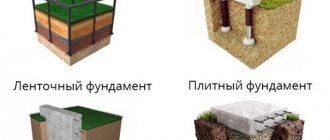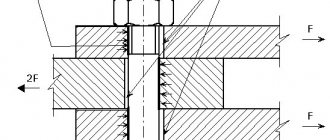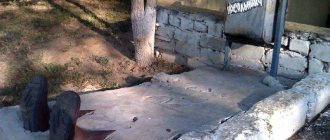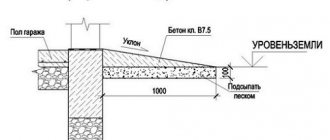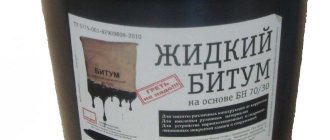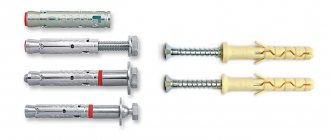The question of what is better in the yard - asphalt or concrete - is relevant for almost everyone at the stage of beautifying a private territory. These two materials are the most acceptable and common options for covering areas in individual construction. They are usually used to make different surfaces, sidewalks, driveways, garden paths and platforms, the space in front of the house and behind it.
To determine whether to lay asphalt or concrete in the yard, you need to carefully consider the properties, advantages and disadvantages of both options, take into account operating conditions, coating requirements, calculate the cost, and choose the most optimal price-quality ratio.
Material evaluation criteria
When determining which is better, asphalt or concrete, several basic parameters are taken into account. Under different conditions and when determining the basic requirements, certain properties of materials may come to the fore or not matter.
Main factors for evaluating materials:
- Comprehensive purchasing and transportation costs
- Costs for preparing the surface and constructing the base itself (how much time and people are needed to complete the work, is it possible to do everything yourself without the involvement of special equipment, purchasing tools, etc.)
- Quality, service life (coating strength, optimal load, resistance to various influences
- Special care required, frequency of repairs
On what basis?
In both the first and second cases, soil preparation is approximately the same, as are the costs for it.
- We decide on a site that will ultimately be covered with either concrete or asphalt.
- Remove the top layer and compact the bottom along the entire perimeter.
- For concrete, it may be necessary to create formwork to keep the material within specified boundaries.
- We pour layers of crushed stone and sand on top, and then compact each one well.
The preparatory layer should go about 15 cm into the ground.
The difference between asphalt and concrete
The main differences between asphalt concrete and concrete are the composition of the mixture; they also determine the operational characteristics and features of working with the material. The asphalt mixture includes the following components: bitumen as a binder, crushed stone or gravel, sand as a filler. Natural mountain asphalt contains about 70% bitumen, while artificial asphalt contains from 13% to 60%.
The composition of artificial asphalt also includes mineral powders. Asphalt can be used as a road surface in road construction, as a waterproofing, electrical insulation, roofing material, as a component of varnishes, adhesives, etc.
Concrete is prepared from cement, crushed stone as filler, sand and water. Various additives can be added to the mixture to change or increase certain characteristics - this could be higher strength, resistance to chemical influences, moisture, frost, etc.
The main difference between asphalt and concrete is that asphalt contains bitumen that is more flexible and does not involve shrinkage, while concrete contains cement (more susceptible to deformation and shrinkage).
Advantages and disadvantages of asphalt pavement
When determining which is cheaper (concrete or asphalt), you first need to study the properties of each material. Asphalting is an extremely popular method of making road surfaces. The material is durable, strong, aesthetically beautiful, smooth. It is usually used for installing coatings where there are no heavy loads. Special equipment is used in the work.
The main advantages of asphalt paving: long service life, high level of strength, flexibility, wear resistance, cost-effectiveness, ease of repair and elimination of deformations, safety for vehicles and people, accessibility, resistance to moisture, the ability to create a perfectly smooth surface.
The technology for laying asphalt is very simple, it requires a minimum of time - after just a few days the coating can be used. You can repair it yourself using cold asphalt technology.
The disadvantages of asphalt include: melting and evaporation of bitumen at high temperatures, the appearance of ruts and dents in the heat, it is necessary to perform maintenance at least once every 3 years (it is necessary to compact the layer, impregnate with bitumen emulsion, fill holes), instability to low temperatures (on the surface cracks and deformations may appear).
Pros and cons of concrete coating
When calculating what is more expensive, asphalt or concrete, you need to carefully study the characteristics of the second material. Concreting is also more relevant today than ever. Concrete perfectly withstands considerable loads, has an increased level of strength, and allows you to do everything yourself, without complex equipment and specialists, which significantly reduces the cost of the process.
The main advantages of concrete pavement:
- Durability - up to several decades, if a high-quality mixture was prepared when pouring and compliance with the technology was ensured
- Reliability and durability
- Resistance to a variety of external negative factors
- High level of wear resistance
- Excellent environmental performance
- No need to involve professionals, special equipment, or expensive tools
- Possibility to carry out all stages of work independently
The disadvantages of a concrete coating include: the surface is deformed in severe frosts (like asphalt, in principle), concrete is dusty, requires an additional coating with a finishing layer or primer, the material gains strength after 28 days, the coating is relatively expensive, not very aesthetically pleasing, if cracks cannot be repaired (only complete replacement of the layer).
Asphalting
Asphalting is a common way of arranging paths and areas in the yard of a private house. The work is carried out according to the standard scheme: first, the soil is leveled, then a layer of crushed stone or clay-sand mixture is poured, and asphalt is laid on top with a 4 cm layer. During the soil leveling process, the storm drain necks are raised to the required level and curbs are installed. For the yard, the bedding layer is 10-15 cm, since intensive loads (heavy vehicle traffic) are not expected.
Choosing a covering for the yard - which is better?
When determining the type of coating, it is worth considering what type of areas are being poured. Thus, asphalt is ideal for covered parking lots, sidewalks, and garden paths. The material is durable and does not imply subsidence and the possibility of grass sprouting or debris accumulation. The coating is even and smooth, relatively inexpensive.
But asphalt is afraid of the sun, so in open areas it can emit an unpleasant odor and soften. If compacted poorly, it may sink under the car. It definitely requires special equipment, so where there are no entrances, it will not be possible to install a covering, nor will it be possible to do all the work yourself. The cost of installation is sometimes several times higher than the price of the material. Maintaining asphalt roads is more expensive, but the surface looks beautiful and aesthetically pleasing.
Concrete is a reliable and simple material, inexpensive, withstands considerable loads, so it can be used for arranging any sites, paths, and driveways. If the concrete surface is reinforced, the coating can be used for any need and can withstand the weight of heavy vehicles.
You can lay the concrete mixture yourself or order it ready-made at the factory, select the desired level of strength, improve certain characteristics through additives, increasing frost resistance, strength, etc. (in the case of asphalt this is not possible). Therefore, concrete is suitable for more complex conditions and requirements; it is safer than asphalt and does not emit any substances.
Concrete looks worse than asphalt pavement, so if the key selection criterion is aesthetics, this option is not relevant. Conventional concrete, provided it is laid independently, involves lower costs; the material is much cheaper to use and prepare.
Where are the best roads? Conclusions.
Some roads throughout the United States actually have better performance and are also in better condition. However, this is due to the fact that concrete on an asphalt cushion is used to build highways in America. Concrete is superior to asphalt in terms of performance parameters, so monolithic concrete roads can be better than asphalt roads.
However, concrete has disadvantages that make it impossible to use it for the construction of highways in Russia.
The main problem is concrete’s intolerance to cold climates and temperature changes. Consequently, in our climate, concrete roads will deteriorate much more than asphalt pavement.
Moreover, even in Western countries, concrete is used only for certain categories of roads, and the bulk of the road surface is built from the same asphalt as in Russia. And the condition of a large number of roads in our countries is approximately the same.
At the same time, it cannot be said that today there is a widespread problem with roads in the Russian Federation, would you agree? Many highways, highways, highways and city roads in our country are in excellent condition. Especially considering our difficult climate.
What is more profitable?
Under equal coating installation conditions, the technical characteristics of asphalt and concrete are approximately the same. Both materials can be used to fill a site of any shape, but to work with asphalt you need an entrance, but not to lay concrete yourself.
Certain properties of concrete (resistance to frost, chemicals, strength) can be improved by adding various additives; asphalt cannot. Laying asphalt and repair work are much cheaper than concreting (especially with reinforcement). But concrete is more durable, can withstand significant loads, and does not require regular maintenance or repair at all, provided that the concrete mixture is laid correctly.
Asphalt is more aesthetically pleasing, but is sensitive to high temperatures, so it is not suitable for covering open areas near the house. Requires careful preliminary compaction (preferably with a special tool), otherwise it may sag. Asphalt can be repaired (sealing holes, cracks) using bitumen and special sealants; the entire layer of concrete must be removed and refilled.
We can conclude that concrete is more universal, since it can be used to cover any roads and sites with your own hands, it is not afraid of anything with additives, does not require maintenance, lasts a long time, and is not subject to repair. Asphalt looks much more aesthetically pleasing, is laid using special tools, is capricious in installation, is susceptible to high and low temperatures, requires regular maintenance, but is cheaper and involves repairs.
The choice of asphalt or concrete should take into account the expected loads, site location, availability of material, the ability to attract workers and special vehicles, requirements for aesthetics and durability of the coating. You can choose one material or equip individual objects with concrete and asphalt in accordance with the above factors.
Concreting
The installation algorithm is the same as for asphalting: leveling the soil and arranging a crushed stone-sand cushion, installing beacons, reinforcing mesh and dividing strips, pouring concrete. For the street, the thickness of the concrete slab is made at least 10 cm.
As you can see, pouring concrete is a little more complicated, and the cost of consumables is higher. In this case, the duration of installation on the same area will be at least 3 days, and after completion it is necessary to wait 3 days until the concrete hardens. Only after this can you walk on it, and it will gain full strength only after a month.
Concrete platform
The advantages of concrete are that all stages of installation can be completed independently, whereas for asphalting you will need special equipment. When installed correctly, the coating itself is durable and can withstand significant loads.
But concrete is considered the least justified solution for arranging a yard:
- Constant dust formation on the concrete surface of the sidewalk. There are special impregnations that fix the surface layer, but this is rarely used for arranging concrete paths on the street.
- Concrete does not tolerate freezing cycles well. When water gets into cracks and cracks, it expands when it freezes and destroys the fragile material. In outdoor conditions, concrete can lose its integrity within 7 years. Therefore, you can fill the site yourself if you have sufficient knowledge of the technology.



